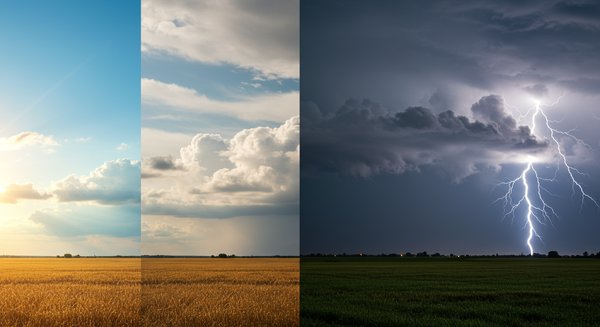Lesson
Introduction to Weather
Welcome to the fascinating world of meteorology! This lesson will introduce you to the fundamental elements that create the weather we experience every day. We will explore temperature, pressure, wind, humidity, and precipitation, and learn about the tools scientists use to measure them. Remember, if you have any questions about Meteorology, feel free to ask the AI Tutor for help. However, please note that the AI cannot predict the weather, so avoid asking it for forecasts.
Understanding these basic concepts is the first step towards comprehending more complex weather patterns and phenomena. Let's begin our journey into the atmosphere!

Temperature
Temperature is a measure of how hot or cold something is. In meteorology, we're concerned with the temperature of the air. This is typically measured in degrees Celsius (°C) or Fahrenheit (°F).
Temperature plays a crucial role in weather because it influences other factors like air pressure and humidity. Warmer air tends to rise, while cooler air tends to sink, creating air currents. The Earth tends to get warmer over the years, known as Global Warming, as you can see from the chart below.
Air Pressure
Air pressure, also known as atmospheric pressure, is the force exerted by the weight of the air above a given point. We often use the term "high pressure" or "low pressure" when describing weather systems.
High pressure systems generally bring stable weather conditions, such as clear skies and calm winds. Low pressure systems, on the other hand, are often associated with unsettled weather, including clouds, rain, and stronger winds. Air pressure is measured using a barometer, and is typically reported in units of millibars (mb) or inches of mercury (inHg).
Wind
Wind is simply the movement of air from one place to another. It is primarily caused by differences in air pressure. Air naturally moves from areas of high pressure to areas of low pressure.
The speed of the wind is measured using an anemometer, and is typically reported in miles per hour (mph) or kilometers per hour (km/h). The direction of the wind is also important, and is typically reported in terms of compass directions (e.g., north, south, east, west). A wind vane is used to determine wind direction.
Humidity
Humidity refers to the amount of water vapor present in the air. Warmer air can hold more water vapor than cooler air. When the air is holding the maximum amount of water vapor it can at a given temperature, it is said to be saturated.
Relative humidity is the percentage of water vapor present in the air compared to the maximum amount it could hold at that temperature. A relative humidity of 100% means the air is saturated. Humidity is measured using a hygrometer.
Precipitation
Precipitation is any form of water that falls from the atmosphere to the Earth's surface. This includes rain, snow, sleet, and hail.
Precipitation forms when water vapor in the air condenses into liquid or solid form, and becomes heavy enough to fall. Different types of precipitation occur depending on the temperature profile of the atmosphere. Precipitation is typically measured using a rain gauge, and is reported in inches or millimeters.
Common Weather Phenomena
Now that we have covered the basic weather elements, let's look at some common weather phenomena that arise from their interaction.
- Fog: A cloud that forms near the ground, reducing visibility.
- Thunderstorms: Storms characterized by lightning, thunder, heavy rain, and sometimes hail.
- Hurricanes (or Typhoons or Cyclones): Powerful rotating storms that form over warm ocean waters.
- Tornadoes: Violently rotating columns of air that extend from a thunderstorm to the ground.
Weather Instruments
Meteorologists use a variety of instruments to measure weather elements. Here are some of the most common ones:
- Thermometer: Measures air temperature.
- Barometer: Measures air pressure.
- Anemometer: Measures wind speed.
- Wind Vane: Measures wind direction.
- Hygrometer: Measures humidity.
- Rain Gauge: Measures precipitation.
These instruments provide valuable data that is used to create weather forecasts and understand climate patterns.

Putting it all Together
Understanding these basic weather elements and phenomena is crucial for comprehending the world around us. The interplay between temperature, pressure, wind, humidity, and precipitation creates the diverse and dynamic weather patterns we experience daily.
By learning about these elements and the instruments used to measure them, you are taking the first step towards becoming a more informed and weather-aware individual. Keep exploring, keep learning, and continue to deepen your understanding of meteorology!












